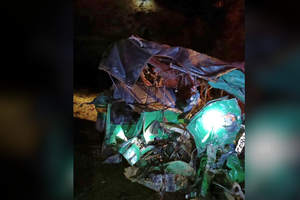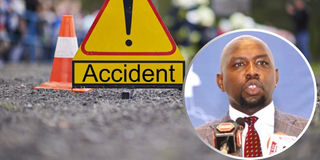
Transport Cabinet Secretary Kipchumba Murkomen (inset) has reintroduced stringent measures to curb road carnage.
When the Transport Cabinet Secretary Kipchumba Murkomen early this week reintroduced stringent measures to curb road carnage, he hoped for positive results.
But his script borrows from the pages of books that registered minimal results, if any.
Among other directives, the CS ordered for the immediate reassessment of drivers of Public Service Vehicles (PSVs) and heavy commercial vehicles in response to the recent surge in road accidents countrywide, which have claimed tens of lives in under three days and left many others nursing injuries.
But these are not any new.
From days when the country was registering less than 1000 annual deaths on the roads, these rules were either mulled or effected for temporary relief before they aware abolished or forgotten until another fatal crash happened.
In August 28, 1984, following a fatal road crash, Mr Peter Okondo, the then minister for Transport and Communication only lamented that Kenya had registered fair share of traffic accidents and suggested tough rules to curb the growing road carnage.
In absolute figures, accidents rose from 5,163 in 1970 to 8,023 in 1983. The number of fatalities increased from 944 in 1970 to 15 in 1983, the minister said, even as road accidents report indicated that fatal accidents constituted 11 to 15 percent as opposed to two percent in some developed countries.
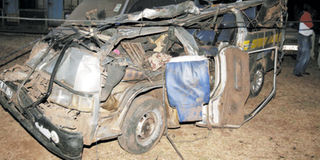
The wreckage of a matatu involved in an accident. Between January 1 and December 20, 2023, some 4,139 people were killed in road accidents, according to the NTSA.
Mr Okondo explained that accidents were expensive and inconvenient, estimating that if the trend continued, the country would lose about Sh1 billion per year and over Sh400 million in property damage per year.
"This monetary loss, coupled with human pain and grief to the citizens, calls for much government concern," he said then.
His worry tamed nothing.
Fast forward to December 2, 1994, and the country lost 35 lives from a single incident. The dailies reported: "Its the worst accident this year".
While the traffic department did not release the official figures placed the deaths on the roads since the beginning of that year at 2,070. This is an average of six deaths a day. In some 1,882 died on the road in 1993 while 1,938 died in 1992, the death toll was 1,938.
In the ‘70s, a roads minister commented that: "Kenya still has fewer deaths and accidents than neighbouring countries."
All ministers since then have always grappled with ways to tame the accidents in vain.
Once, in April 15, 1967 as the then Vice-President and minister for Home Affairs Daniel Moi waded into the matter, warning that stiffer measures would be taken against notorious drivers if the rate of accidents on the highways continued .
"Should this trend continue, I reserve my right not only to prosecute the drivers, as has been the case up to now, but also to consider putting notorious vehicles off the road or prosecuting the companies involved. It is regretted that such measures are forced upon us by sheer lack of co-operation on the part of the people concerned," Mr Moi said.
"The casualty figures on Kenya's highways are known to everybody and I need not even state them in order to make a point. If the motorists of this country observed the traffic laws and regulations the rate of accidents would be cut considerably."
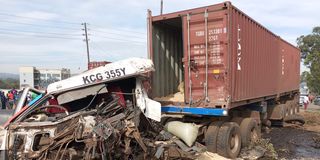
The wreckage of a matatu and a trailer that were involved in a road crash at Eveready roundabout in Nakuru on December 31, 2023.
The more things change, the more they remain the same in the transport sector as set measures flop and are reintroduced in different wordings for the same results.
Consequential, however, was the night-travel ban on tankers and heavy lorries in May 25, 1970. The then minister for Power and Communications Ronald Ngala even warned that the order would extend to buses.
By his word, no tankers nor heavy commercial vehicles were allowed to be on the roads between 6.45pm and 6.15 am. The ban followed a national outcry after 33 people died when their bus caught fire following a collision with a lorry near Nakuru. Three days later, however, he lifted the ban.
"In future, notorious offenders may have their licences cancelled for good," Mr Ngala said while imposing the ban, describing as "senseless" some of the accusations brought against the directive.
Still troubled by the menace, Mr Ngala, while urging the National Assembly to adapt a bill that would tame he traffic mess, estimated that Kenya would lose about £150 million worth of property during the next 20 years if the present rate of road accidents continued.
The Bill sought to give Mr Ngala powers to lighten up all past loopholes and introduce stiffer penalties for offenders. Under the bill, driving schools would have to be registered and instructors possess proper qualifications before undertaking driving tuition.
Further, the bill was to allow for the registrar of motor vehicles to revoke driving licences or ask others to re-sit a driving test.
It remained at that.
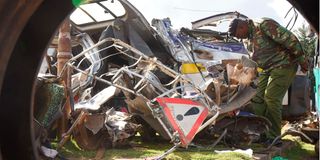
Timboroa OCS Robert Kitali inspects the wreckage of a 14-seater matatu that was involved in an accident along the Nakuru-Eldoret highway.
In 1989, a report hailed for being so blunt on the situation of the road carnage was presented to the Minister for Transport and Communication, Joseph Kamotho.
The report spelt out stark facts about carnage on Kenyan roads – obvious and probable causes – apportioned blame and suggested remedies. But like the biblical cornerstone, the report, researched on and compiled by a specialist organisation, appears to have been shunned.
More than a year since the report was presented to the Government, it could still be gathering dust in some office.
When the situation threatened to slip out of control, in February 1, 1991 the very report was touted as the panacea.
Titled An Absence of Manners, the special road safety report was prepared by the Automobile Association of Kenya (AA) and observed that it was never too late to implement the report.
The report was relegated but the causes of road accidents are the same now as they were then.
Attempts at addressing it saw the government in 1995 establish the Road Safety Authority, an autonomous multi-disciplinary body comprising doctors, lawyers, researchers and engineers to oversee traffic matters with a view to reducing the escalating road carnage.
According to the Minister for Transport and Communications, Mr Dalmas Otieno, the main cause of the spate of road accidents was human error, which accounted for 83 per cent of the crashes. He said other factors like the environment and vehicle condition accounted for 17 per cent of the accidents.

The wreckage of the 'Party on Wheels' bus at the Subuiga police station on November 20, 2022.
In April 3, 2000 following a head-on bus crash that killed 76 people, the case for speed governors was revisited.
At the time, many Kenyans felt that since governors had worked in other parts of the world, they should be tried in this country.
Had the speed limiters requirement enforced as envisaged by the Traffic Act, Chapter 403, Subsidiary Section 41A, road carnage would have been minimised.
The section spelt that with effect from January 1, 1988, the engines of all public service vehicle whose tare weight exceeded 3,048 kilogrammes, should be fitted with a governor whose speed was capped at 80km/h. But the rule was later withdrawn after an outcry from PSV owners who claimed that the cost of the speed governors was prohibitive.
The rule was set to be reintroduced yet again in 1996, but another major protest by the vehicle owners cowed the government into abandoning the plan.
The then Minister for Transport and Communications, Mr Dalmas Otieno, on February 8, 1996 announced that PSVs with a capacity to carry more than seven passengers and all commercial vehicles be fitted with over speed limiters.
In August of the previous year, President Moi had ordered that all PSVS be fitted with the speed limiters on the assembly line, both in this country and abroad, before being introduced on Kenyan roads.
Then came the introduction and subsequent enforcement of what was dubbed as John Michuki rules in 2003.
The then Transport Minister had matatus install safety belts on vehicles as all public transport vehicles, including commercial vehicles whose tare weight is above 3,048, having to be fitted with speed governors from February 2004.
The measures were part of a drive to improve safety on Kenyan roads, where an average of 3,000 are killed in accidents every year at the time.
Vehicle owners will be liable to a Sh500 fine for every seat not fitted with a safety belt, or for seat belts which are not of the right standard. The new laws also sought to push unruly mobs out of the matatu industry as it requires drivers to wear uniform and special badges.
And to ensure competence at the wheel, the law spelt, public service drivers would be tested and certified every two years.
On the day the law came into effect in February 2004, the DN reported a transport paralysis across the country. The move was greeted with resistance and skeptism.
But it reported the greatest effect the transport has ever had in as far as curbing road carnage has ever happened in the country.

A breakdown vehicle prepares to tow away the wreckage of the bus that collided head-on with a 14-seater matatu on the Meru-Nanyuki road on October 8, 2022.
It easily became the benchmark of success in taming the largely ungovernable sector.
When Chirau Makwere took over as the transport minister, he further tightened the noose.
In July 13, 2006, drivers who have been involved in more than two accidents Mr Makwere threatened, may be blacklisted and have their licences withdrawn.
Further, Mr Makwere wanted physical fitness to be a requirement for employment as a driver or conductor in the buses.
Matatus will also be required to observe stricter regulations or be deregistered, according to Transport minister Chirau Makwere who wanted that every six months, commercial and public service vehicles be required to undergo mechanical inspection and be issued with a certificate for them to be allowed to operate.
The minister noted that public transport operators had deliberately ignored rules introduced in 2003 and which had initially reduced the rate of road accidents.
To grip the sector, in December 17, 2008, Mr Mwakwere expressed desire to gazette a new regulation to curb drunk-driving during the Christmas season. A similar gadget, Alcoblow, first introduced in 2006, had been withdrawn after two motorists successfully challenged its legality in court.
For a moment, the government appeared to have wrested the menace before it slipped. Subsequent ministers have always borrowed from the Michuki rules that registered great success, again, in vain.
In 2018, the Interior Cabinet Secretary Fred Matiang'i and his Transport counterpart James jointly ordered police to enforce the infamous "Michuki rules".
The rules introduced by the no-nonesense Cabinet minister John Michuki in 2003, the duo announced, would be enforced with more ruthlessness and discipline. Mr Michuki died in 2012.
They said the rules were not suspended and that government agencies would work together to ensure sanity prevailed on Kenyan roads.
The return of the dreaded public transport regulations was for the umpteenth time mulled to tame rogue matatu drivers in the wake of concerns over increasing road accidents.
A staggering 91 per cent of the crashes were attributed to human related factors such as speeding, reckless driving, dangerous overtaking and drink driving, tendencies which the government hopes to curtail by enforcing the Michuki Rules.
Public service vehicles will have to be fitted with speed governors, safety belts and painted with a yellow line.
Similarly, all PSV drivers and conductors will be required to wear uniforms and badges and prominently display their photos in the vehicles.
Laxity and corruption among traffic police and NTSA officers have given rise to chaos on the roads resulting in serious injuries and deaths.
This was a reaction to an accident that had seen 58 people die in a horrific accident involving a bus in western Kenya. As of 2018, road accidents had on the rise and had claimed 8,000 lives.



